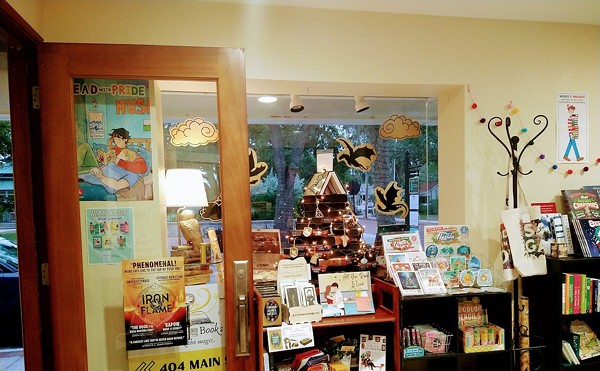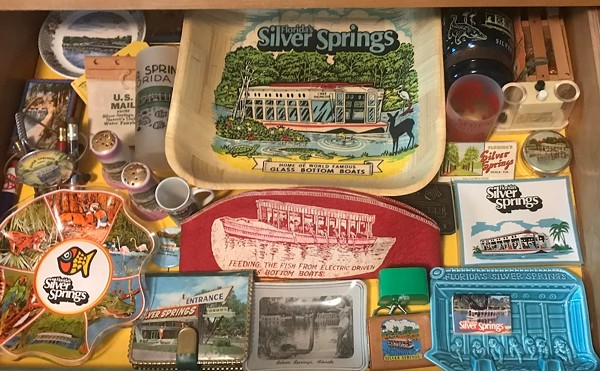If you've ever seen a Hummel figurine, it's hard to forget the sickeningly sweet ideal of childhood that they promulgate. The collectible ceramic knickknacks — which depict rosy-cheeked, blond children wearing vapid expressions of mild surprise — would make any postmodernist cringe. They're the kind of kitschy, pop-cultural curiosity Roland Barthes would have deconstructed with glee, peeling back a veneer of innocuousness to reveal nefarious ideological currents pulsing underneath (e.g., fantasies of racial purity and childhood naiveté).
Attracted to their strangeness, artist Andréa Keys Connell had her first encounter with Hummel figurines as an undergraduate studying ceramics. As a flippant gesture to a class assignment, she sculpted a purposefully tacky ashtray that incorporated a miniature, Hummel-esque child as a chronic smoker, unable to breathe without the assistance of an oxygen machine. (Pastimes more typical of Hummel figurines include communing with small animals and seeking shelter from raindrops under large umbrellas.) Years later, the figures reemerged in her mind as inspiration for a very different body of work.
An exhibition of that work is now on view at the Florida Holocaust Museum in St. Petersburg. Translated to large, nearly monumental scale and imbued with a very specific set of associations, the figures — still vaguely Hummel-esque but noticeably transformed — function as a venue for Keys to communicate her experience of intergenerational trauma. Rather than mere irony, her figures now convey a disturbing sense of suspended childhood: an emotional purgatory characterized by feelings of abandonment and despair. The shift grew out of her response to a family secret passed down to her at age 16, which the artist, now 29, was told never to repeat: her grandparents had been survivors of the Holocaust.
Given the subject, you can guess that this secret is not one Keys decided to keep — a move toward familial healing that she credits to her brother, Jake, also an artist, who gradually encouraged their grandmother to tell her story by giving her a tape recorder. In 1998, after more than 50 years of silence, Keys' grandmother gave a videotaped interview to the USC Shoah Foundation Institute; three years ago, she passed away.
After World War II, Keys explains, her grandparents moved to Virginia and became Baptists, disavowing their religion and their heritage in the hope that none of their descendants would be discriminated against. (For her part, Keys abstains from religious practice but is proud of her Jewish heritage in a cultural sense.) Her grandfather, who had worked in a forced labor camp, died before she was born. Her grandmother had survived Auschwitz.
Little wonder, Keys says, that such experiences planted the seed for a painful legacy of secrecy, fear and disavowal of identity. Worst of all, she watched her grandmother struggle with a tragic inability to express feelings to those closest to her, setting a generational precedent of emotional distance that Keys describes as a cycle in which the victim becomes the unwitting perpetrator of further pain.
"Nana was really terrible at being able to fully give herself to love," Keys says. "She didn't respond to affection very well."
Keys' sculptures — large-scale ceramic figures that resemble lost children — resonate with that uncanny sense of simultaneous presence (physical) and absence (emotional). "Inherent Longing" creates a theatrical tableau of ghostly white ceramic figures: a kneeling girl-woman with plump cheeks and a doll-like body surrounded by a pack unidentifiable rodents. From the girl's extended fingertips, which she offers with eyes closed, the rodents appear to seek nourishment. The drama resides in imagining what follows this pregnant moment. When the rodents — simultaneously repellent and desperately vulnerable, and equally uncanny in that they don't resemble any particular species — figure out that the girl can't feed them, will they harm her? Do they pose a threat, or do they merely need sustenance? In this world, the two possibilities are indistinguishable.
Elsewhere in the museum's galleries, a series of brown clay figures clustered together, also adrift in an emotional no-man's-land, evince a more obvious response to Hummel figurines. Chubby and crowned with windswept hair — aesthetic conceits of the saccharine collectibles — these figures bear wide, staring eyes and sit or stand in postures that attest more to unending depression than innocent childhood play. One figure, facing a spotlighted wall, reaches forward in a gesture that wistfully combines reaching with goodbye; another child, with one arm extended in a silent request for help, sinks into the floor; a third slumps against the wall as if overcome by lethargy. Crafted from unglazed clay, the figures look as if they have been made of milk chocolate, a visual association that adds to their disturbing surreality.
The exhibition marks the first time Keys has shown her sculptures in a context that specifically memorializes survivors of the Holocaust. Though just a year out of graduate school, she has already been the focus of a solo exhibition at the Kentucky Museum of Art and Craft in Louisville, and later this month she begins a yearlong position as a visiting artist at Virginia Commonwealth University's highly regarded studio art program. While its resonance with her family history makes the opportunity to exhibit at the Florida Holocaust Museum especially meaningful, Keys says, she more often frames her work as relevant to survivors of any kind of trauma (e.g., from sexual abuse to violent crime) and hopes that it speaks to many audiences.
One of the motivations behind her work is a hope that viewers may be inspired to break patterns of traumatic inheritance in their own lives. Deciding to address a legacy of pain and silence through art has helped Keys understand the context in which she grew up as well as the power she has to create change as an adult.
"I really just wanted to love everybody in my family — and in order to love everybody in my family, I had to really understand why they couldn't give some of what I wanted to give back," she says.















